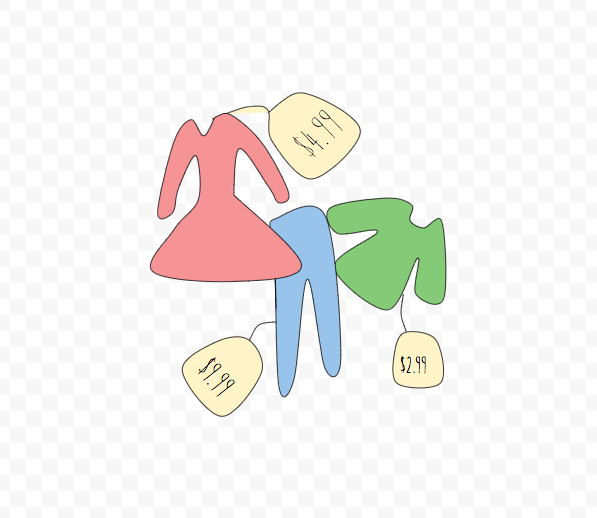Fast Fashion: More Than a Retail Price

On April 24, 2013, tragedy struck in Dhaka, Bangladesh. The eight story garment factory Rana Plaza collapsed, killing over 1,000 people. Despite the heightened media coverage that this disaster received, it was neither the first nor the last of its kind. In addition, it may have been preventable: In the time leading up to the collapse, several Rana Plaza employees reported that they had reason to doubt the building’s structural integrity. Despite these warnings, authorities forced them to return to work, desperate to turn a profit: to create less expensive, and therefore more desirable clothing than their thousands of competitors.
From the perspective of a consumer, the fast fashion industry seems simple and ideal. It offers on-trend, readily available clothing for lower prices than ever. But the increasing affordability of the clothes we wear comes at a great expense to both the environment and the citizens of developing countries. Many people are already aware of this issue. But the gap between knowing about an issue and truly understanding its impacts runs deep. One in every six people on Earth works in the fashion industry, and 40 million of them are garment workers. These people, mostly women — and sometimes even children — are subjected to long hours, low pay, unsafe working conditions, and even sexual harassment and assault from coworkers and bosses. Not only does it subject tens of millions of people to terrible conditions, the fashion industry is destroying the environment. It is the second most polluting industry in the world, with the U.S. alone producing 11 million tons of textile waste every year.
As the world becomes more globalized, clothing production is being fast-tracked and relocated to developing countries. In the 1960’s, 95 percent of clothing sold in the U.S. was produced within the country. As of 2015, that number had dropped to only 3 percent. Defenders of the fast fashion industry claim that it benefits the global economy, or that these are the only jobs available to these people and this is the best they can hope for. However, these excuses are feeble when measured against the suffering and lifelong exhaustion that often accompany a sweatshop job. Shima Akhter, a Bangladeshi garment worker, was featured in the documentary “The True Cost,” which explores the structural flaws integral to the fashion industry.
“There is no limit to the struggle of Bangladeshi workers,” she said in an interview. “People have no idea how difficult it is for us to make the clothing. They only buy it and wear it. I believe these clothes are produced by our blood. I don’t want anyone wearing anything which is produced by our blood.” And Akhter is not alone in her discontent with modern clothing production. In Cambodia, a group of garment workers took to the streets in peaceful protest, demanding higher wages. Although they requested only $160 per month, they were met with violence. Police opened fire on the crowds, killing five and injuring over 40.
In addition to displaying a lack of concern for human lives, the fast fashion industry puts little stock in the importance of environmental sustainability. “The great threat is that capital must continue to expand infinitely in order to survive,” John Hilary, the executive director of anti-poverty charity War on Want, said. “It can’t have any limits, and the ocean and the natural world does have limits.” In recent years, society’s constant hunger for consumption has outstripped the capacity of the natural world to produce. For example, according to “The True Cost,” the river town of Kanpur, India, is home to one of the biggest leather producers in the world. Every day, 50 million liters of toxic wastewater from the plant are dumped into the River Ganga, which in turn supplies drinking water to most of Northern India. Those living in Kanpur are most affected, especially children. It is common for them to have chronic health conditions, such as persistent skin rashes, numb limbs, stomach problems, and even a significantly heightened risk for developing cancer. The chemicals from the leather treatment, including chromium-6, contaminate not only drinking water but also produce and animal products.
Even those consumers who attempt to be ecologically responsible by donating to thrift stores are contributing to the problem more than they know. In truth, only about 10 percent of clothing donated to thrift stores is actually sold there. The other 90 percent is sent to developing countries to be resold at even lower prices. This can have adverse effects on the economies and internal fashion industries of these nations. Since the resale clothes are less expensive, many thriving fashion industries within small countries have now lost their market. This forces them to become exporters, making cheap clothing to sell abroad that will one day be returned to further amplify the problem at hand.
Although this situation seems bleak, there are alternatives. One way that individuals can be more responsible in their consumption is to simply make clothes for themselves. Annri Vroom, a resident of Ann Arbor, has been doing so for most of her life.
“In order to spend time with [my mother], I’d hang out on the floor of the sewing room. And so a lot of it was just by her passing me something to work on to keep me busy while I was in there,” she said. “Once I was maybe in middle school, I really started to be interested in [the] machine and wanting to sew.” At this point in her life, Vroom says that between 65 percent and 75 percent of her wardrobe consists of clothing she has made herself. She suggested that anyone interested in sewing their own apparel should begin by adding details to clothing items they already own. “If you have a needle and thread, you can make a mark on something and it’s your own,” she said. “If you’ve got a creative inclination, you can really have fun with something.”
Many companies are also beginning to design ethically and environmentally responsible clothing lines. One such organization is People Tree. According to “The True Cost,” Safia Minney founded People Tree 20 years ago in Japan.
“Fair trade is a citizens’ response to correcting social injustice and an international trading system that is largely dysfunctional,” Minney said during the film. “Workers and farmers are not paid a living wage and the environment is not considered at all to make products that you buy every day.”
People Tree is not the only business working toward ethical and sustainable production. TS Designs, a small t-shirt printing company based in North Carolina, also prioritizes sustainable and ethical production. Founded in 1978, the business was thriving up until the North American Free Trade Agreement (NAFTA) passed in 1994.
“Our business was destroyed by NAFTA,” says Eric Henry, president and co-founder of TS Designs. “We wanted to stay in a textile business, we wanted to stay in the area, but we had to reinvent ourselves.” The company now utilizes what Henry calls a “triple bottom line,” focusing on maintaining the well-being of people, the planet, and profit. It also emphasizes the importance of having a transparent and trackable supply chain. A line of t-shirts with individual tracking numbers is currently in the works. Henry explained in an interview that although their products are more expensive in dollars, this cost is outweighed by the negative impact most other brands have on the world at large.
“We will compete with anybody in the world. And you gotta bring price to the table,” he says. “But let’s talk about our social and environmental impact. When we pay people a living wage, not a minimum wage, how does that impact [them]? When we use organic cotton or conventional cotton, what does that mean? When our transportation footprint is 500 miles instead of 13,000 miles? But we just don’t have the metrics to measure this.”
Although the road to sustainable and ethical production may seem steep, things are already beginning to change as the global psyche becomes more aware of the problem at hand. Even the popular clothing store H&M has recently produced a line of “conscious” designs. This isn’t happening without reason: All major corporations run on a system of supply and demand, and as a result consumers have more power than many people realize. If the consumer base of the fast fashion system demands change, the world’s major corporations will provide it.



